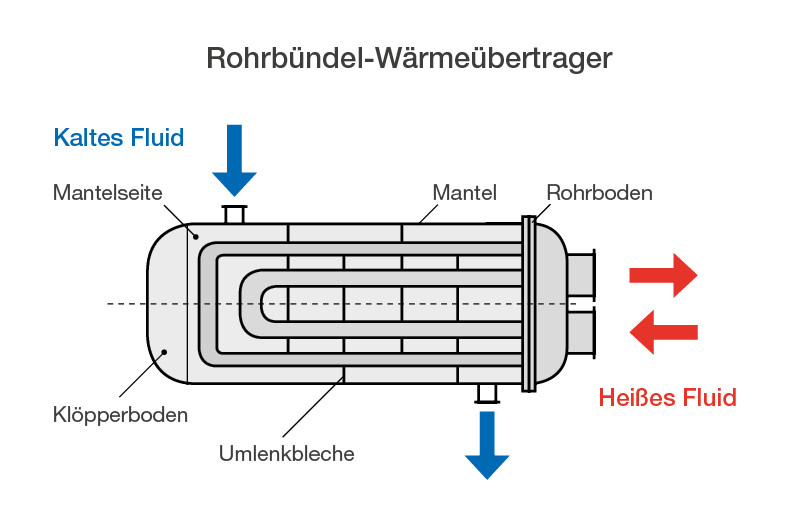Heat recovery in ventilationMethods of heat recovery in ventilation
Modern houses are built energy-efficiently to protect the environment and save heating costs. When it comes to ventilation, architects and planners are increasingly turning to mechanical or fan-assisted ventilation with heat recovery. Not only does it provide fresh air in the living room and thus increase living comfort, it also provides DIN-compliant ventilation to prevent mold. Especially with regard to the energy saving potential in building, which is given clear guidelines by the Energy Saving Ordinance (EnEV), the importance of controlled living space ventilation with heat recovery comes to the fore. A heat exchanger in a ventilation system can recover up to 90% of the thermal energy. This depends on the device structure and the method of heat recovery. In the following sections you will find out which methods are available for heat recovery in ventilation and how the principle of the heat exchanger works.

Counselor:
- Significance of heat recovery for the energetic evaluation
- Build energy-efficient
- Ventilation concept for ventilation with heat recovery
- Overview of heat exchangers in ventilation
- Recuperative heat recovery in ventilation
- Plate heat exchanger for mechanical ventilation
- Tube bundle heat exchanger for heat recovery
- Recuperative heat recovery with central ventilation
- Regenerative heat recovery with ventilation
- Heat recovery in ventilation through solids
- Rotary heat exchanger in industrial ventilation
- Conclusion
Significance of heat recovery in ventilation for the energetic evaluation
The requirements for house construction are growing steadily. Buildings should be constructed as tightly as possible in order to store the energy in them. The Energy Saving Ordinance (EnEV) has defined special guidelines that must be observed when building a house. In the following we would like to give you a brief overview:
Energy-efficient building - guidelines for heat recovery
Tightly constructed building envelopes, reinforced roof insulation and multiple-glazed windows are intended to reduce the primary energy requirement of the house. On the one hand, this is intended to achieve long-term goals in the federal government’s energy and climate protection policy. On the other hand, they help homeowners to keep their property energetically efficient and save heating costs (you can read more about the EnEV in our guide to the Energy Saving Ordinance).
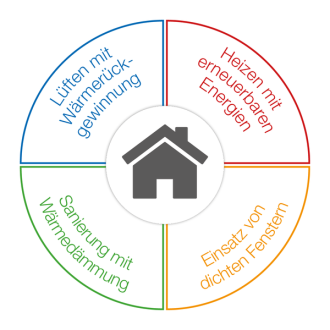
But where energy is saved by the compact design, problems arise again: The air can no longer circulate naturally (through cracks in the joints or through a permeable building structure). Stale air enriched with moisture and pollutants (vapors from home textiles, furniture, etc.) ensures that the well-being and health of the residents as well as the building structure of the house are attacked. For this reason, the EnEV requires a minimum air change. How this can be achieved in detail is part of the ventilation standard DIN 1946-6, which is used as the basis for the ventilation concept. You will find an overview of the ventilation concept in the further course of the guide.
Ventilation concept for ventilation with heat recovery
In order to be legally on the safe side, a ventilation concept according to DIN 1946-6 is not only sensible for specialist planners, but also mandatory according to the current energy saving ordinance.
This applies to the construction of a new house as well as to existing residential buildings retrospectively, if in the course of a renovation
more than a third of the windows replaced or
more than a third of the roof area in single-family houses can be insulated.
Ventilation with heat recovery can be designed for nominal ventilation in accordance with DIN 1946-6. This is the ventilation level that defines both hygienic standards for the health of the residents and ensures adequate moisture protection in order to protect the building fabric from mold in the long term. The design according to standard-compliant nominal ventilation becomes important when it comes to applying for funding from the KfW.
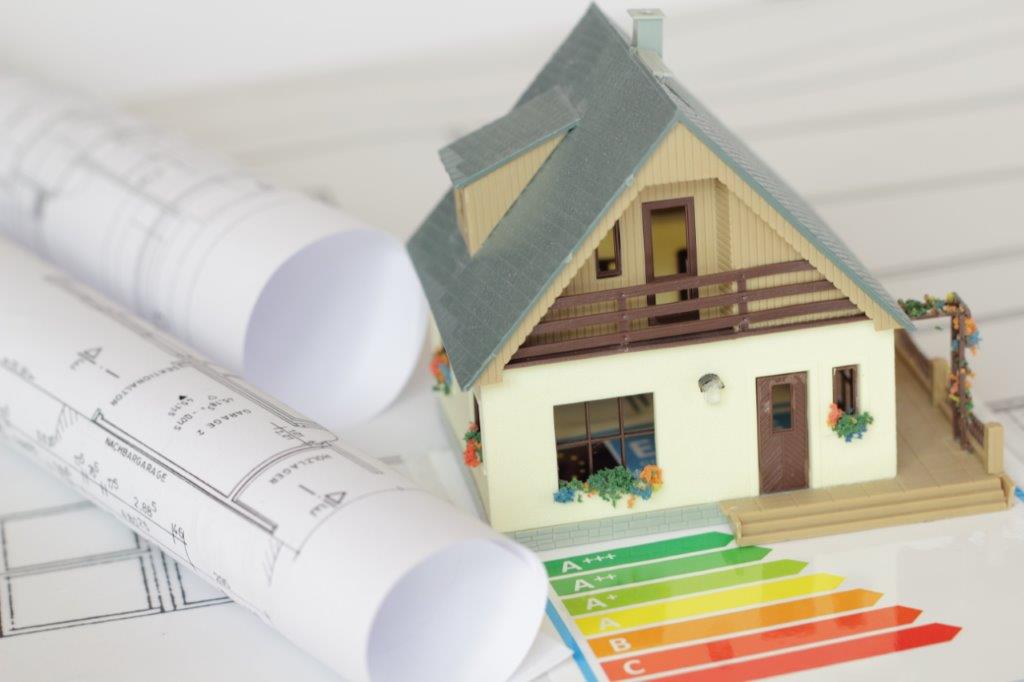
Overview of heat exchangers in ventilation - methods of heat recovery
Basically, the principle of heat recovery works by transferring thermal energy of the exhaust air from the interior to the fresh air supplied from outside or by transferring it to a storage mass with subsequent release to the subsequent air flow. This means that less heating energy has to be used to keep the temperature in the interior constant (warm). This saves heating costs and also protects the environment. The heat recovery can be technically implemented in various ways. We roughly distinguish between two variants:
- recuperative heat recovery (lat. recuperare = to regain)
- regenerative heat recovery (lat.regeneratio = to generate again)
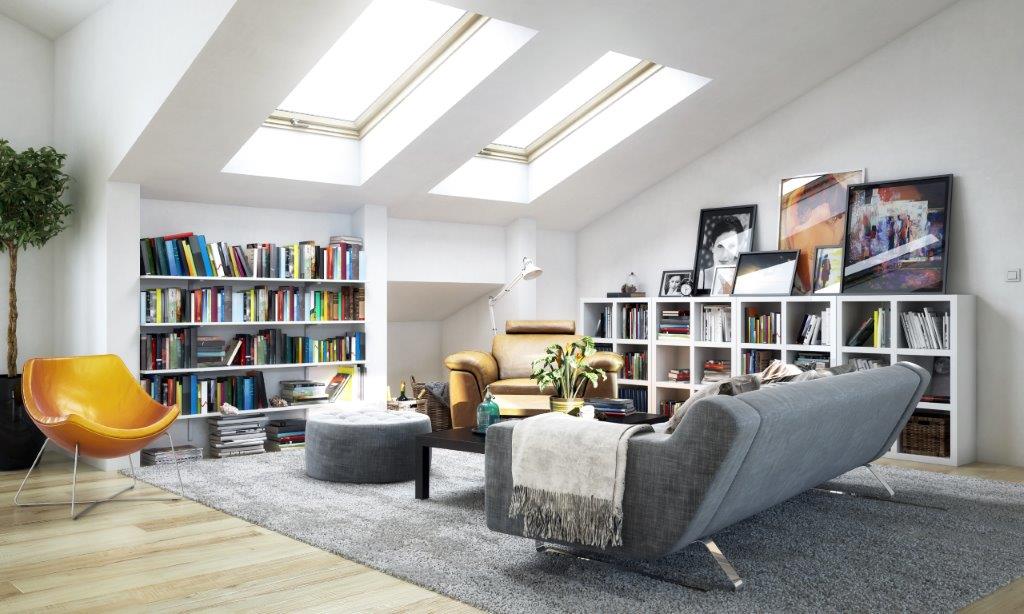
Recuperative heat exchangers are mainly used in practical applications in central ventilation systems. A characteristic feature is the separately conducted supply and exhaust air flow.
Regenerative heat recovery takes place through a short-term heat storage system, through which incoming and outgoing air flows alternately. This type of heat recovery is mainly used in decentralized ventilation systems.
Recuperative heat recovery in ventilation
When exhaust air and supply air flow past each other in separate ducts, we speak of recuperative heat recovery. The exchange of thermal energy takes place via so-called heat exchangers. These can occur in a tube bundle or a plate shape and usually consist of particularly conductive metal such as aluminum or a special plastic. A special feature of the heat recovery via heat exchangers in ventilation is that the air flows do not come into contact with each other and therefore there can be no mixing of any kind. Odors or other solid particles are hardly or not at all transmitted. Ventilation with a heat exchanger is usually used where constant high air volume flows are required. The recuperative heat recovery method is mainly used in the central systems.
Recuperative heat exchangers for ventilation:
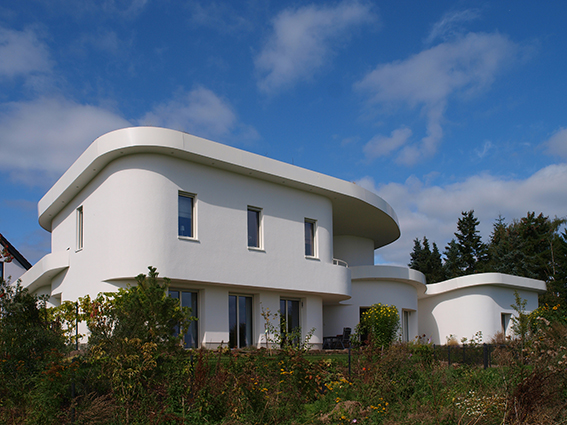
- Enthalpy heat exchanger
- Tube bundle heat exchanger
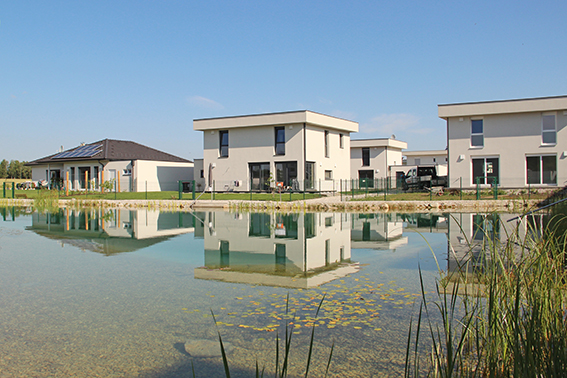
- Cross-flow heat exchanger
- Counterflow heat exchanger
Plate heat exchanger for mechanical ventilation with heat recovery
The plate heat exchanger is mainly used in the central ventilation systems. Here, several thin aluminum plates or foils made of special plastic form the partition walls for the air flows. Warm exhaust air and fresh (cold) outside air flow through these spaces using the co-current principle, i.e. in the same direction, in the cross-flow principle, at right angles or in the counter-flow principle, i.e. in opposite directions past each other. The energy is transferred from the air with a high energy level (room air) to the heat exchanger and from there back to the outside air, which has a lower energy level.
With the cross-countercurrent principle, both air flows are crossed and guided past each other in opposite directions. The contact time during the heat transfer is extended, which further increases the temperature efficiency and the efficiency of the heat recovery compared to the cross-flow principle.
The geometry of the heat exchanger, the material, the air volume flow, the temperature difference, the size of the heat exchanger and the flow time also have an impact on the degree of heat recovery in plate heat exchangers.
The following applies:
The faster the air exchange, the less efficient the heat recovery.
Counter-flow heat exchangers have a higher heat transfer than cross-flow heat exchangers with the same area.
With special constructions, such as a triangular or square duct construction, a larger heat transfer surface is created with the same construction volume
Attention humidity recovery: A humidity recovery does not exist automatically with conventional heat exchangers. The temperature differences can often lead to larger amounts of condensate. This once again requires the installation of a corresponding pipe for the process, which is reflected in the installation effort and costs.
The enthalpy heat exchanger was specially developed for moisture recovery during ventilation. In contrast to conventional plate heat exchangers, a membrane separates the supply and exhaust air flow. Due to the osmosis principle, this membrane can release a large part of the moisture from the (warm) exhaust air to the dry and cold supply air. Since the moisture recovery in the enthalpy heat exchanger cannot be regulated, it is mainly suitable for larger residential buildings with little occupancy or particularly little humidity.
Tube bundle heat exchanger for heat recovery
The tube bundle heat exchanger is also one of the recuperative methods of transferring thermal energy, as the two air flows – warm and cold, are separated from each other and the heat is transferred via the tube wall. The recuperator consists of a large number of tubes with a small diameter, which are arranged in a hollow cylinder made of sheet steel. In the simplest case of the tube bundle heat exchanger, there is only one small tube in a large one. Warm air is drawn in via the larger one, while the cold air that is passed through the smaller pipe is heated indirectly via the partition. The principle of heat recovery through the tube bundle heat exchanger is now rarely used in living space ventilation.
Recuperative heat recovery in the central system
The functional principle of recuperative heat recovery is mainly used in the central ventilation systems. The central system works via a single device that is connected to the entire house by a pipe system. The house is divided into supply and exhaust air rooms. Living and sleeping areas usually belong to the supply air rooms. Exhaust air rooms are the rooms in which moisture peaks can occur more frequently, such as the kitchen and bathroom.
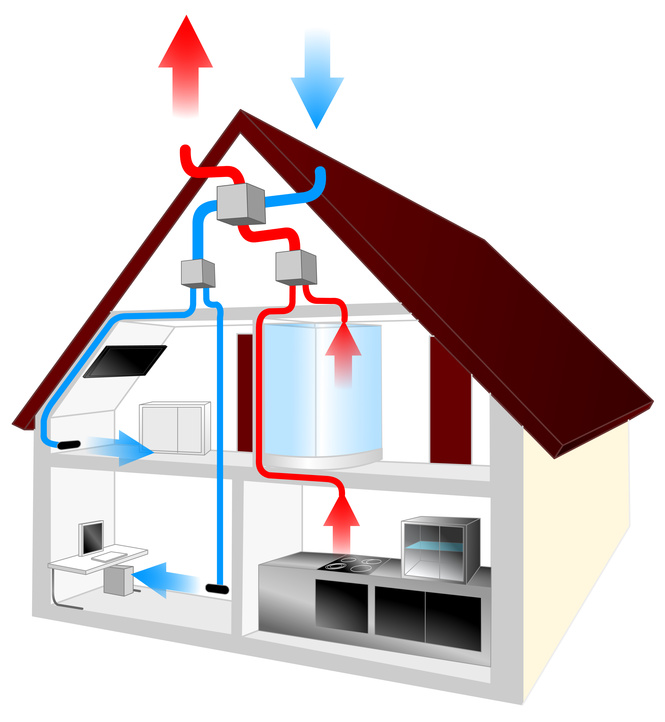
Used air is sucked in via the exhaust air space, reaches the plate heat exchanger of the central device via the pipe system and is then released to the outside as so-called “exhaust air”. At the same time, fresh outside air is sucked in, gets back into the supply air pipes via the recuperator of the central system and is then transferred to the corresponding rooms. With the central system, a heat recovery rate of 70% to over 90% is possible.
An upstream heating register can ensure that the thin aluminum or plastic plates in the heat exchanger are protected from frost even at low temperatures. This is operated with increased energy consumption, which can significantly increase the operating costs compared to decentralized ventilation systems. In summer, however, a summer bypass is often used to completely bypass the heat exchanger in the device.
The additional energy requirement of the preheater can be avoided with an upstream geothermal heat exchanger. However, the installation is associated with high effort and costs and is also only suitable for large properties.
Regenerative heat recovery with ventilation
With regenerative heat recovery, thermal energy is temporarily “stored” in a solid or liquid body and released back to the colder supply air via this surface. The storage mass is alternately flowed through by cold and warm air. The intermediate storage device, also called a regenerator, can be fixed in the ventilation device as a solid body or it can be movable (rotary heat storage device). These regenerators are used for heat recovery especially in decentralized ventilation systems and in industrial ventilation.
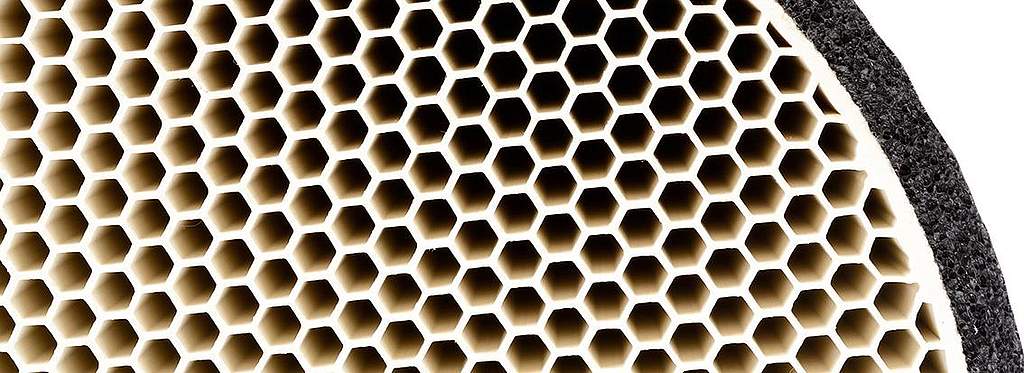
Heat recovery in ventilation through solids
The heat accumulators in the decentralized ventilation systems usually consist of high-quality ceramic bodies. A reversing fan changes direction at intervals of 70 – 90 seconds and ensures the alternating direction of the air flow. In the exhaust mode, warm air flows through the solid, which charges the heat accumulator inside the fan. In the subsequent supply air interval, cold fresh air is drawn in from the outside, absorbs the temporarily stored heat and then flows preheated into the room. In particular, the honeycomb structure of a heat accumulator made of ceramic achieves a high level of efficiency in heat recovery. The transfer area is maximized by the honeycomb structure, which means that even more thermal energy can be temporarily stored.
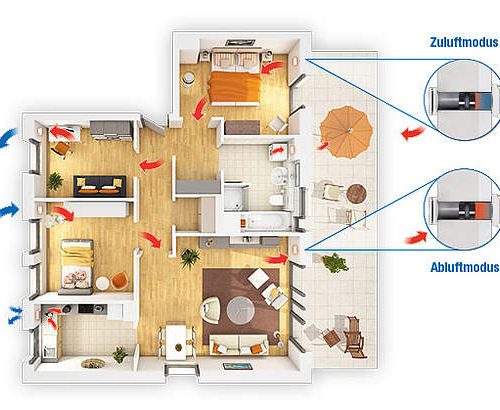
Regenerative heat recovery through ceramic heat storage is mainly used in living space ventilation with decentralized ventilation devices. The simple installation principle of the devices directly in the exterior walls, which also enables subsequent installation in the course of an energetic renovation, has made decentralized fans particularly popular on the residential ventilation market in recent years. In the meantime, this type of device has established itself and is even ahead of the central systems in terms of quantity.
You can find out more advantages of the decentralized ventilation system for your building project in our guide.
The high heat capacity of ceramics enables heat recovery from 80% to over 93%. The dirt-repellent surface is also suitable for hygienic ventilation requirements and is easy to clean. For this reason, the ceramic version has become the standard over the aluminum version.
Advantages over recuperative heat recovery from ventilation systems:
- No frost protection necessary: problem-free operation down to -20 degrees
- Summer operation: heat barrier in the opposite direction
- Hygienic and easy to clean
Note: Decentralized fans with ceramic heat storage are also suitable for summer operation. The principle of heat recovery with a solid also works in the opposite temperature constellation. When the outside air is particularly warm in summer, the ceramic heat accumulator acts like a thermal barrier and keeps the interior cooler for longer.
Note: The ceramic heat accumulator was developed for the first time around 20 years ago and used in the inVENTer ventilation units. Since then, this structure has established itself as the market standard for decentralized ventilation units. Learn more about the original.
Heat recovery in industrial ventilation: rotary heat exchangers
In contrast to ventilation systems with a fixed heat exchanger, the circular storage mass in rotary heat exchangers moves “rotating” around an axis. On one of these sides, warm exhaust air is fed through a duct onto the rotating disk, which heats up as a result. During the rotary movement, the pane is then guided over the supply air duct on the other side with a time delay. The cooler supply air flows in there, absorbs the thermal energy of the rotating disk and is then heated and fed into the building. The rotating disk consequently cools down again and can therefore again absorb thermal energy from the exhaust air in the further rotation.
The rotary heat exchanger is also known as a heat wheel due to its design. It consists of a multitude of thin foils arranged like a kind of corrugated cardboard: a smooth foil alternates with a corrugated layer. This results in a triangular shape that forms a kind of channel. The foils are about 0.05 mm to 0.12 mm thick and usually consist of aluminum or another conductive stainless steel. In addition to heat, the rotary heat exchanger can also transfer moisture. If there is condensate on the exhaust air side, this moisture is absorbed again by the outside air. This means, especially in winter, when the air in the interior is particularly dry, the rotary heat exchanger can provide moisture by taking over larger amounts of condensate.
Due to their size, they are primarily used for the ventilation of industrial buildings (heat wheels can have a diameter of up to 2 meters).
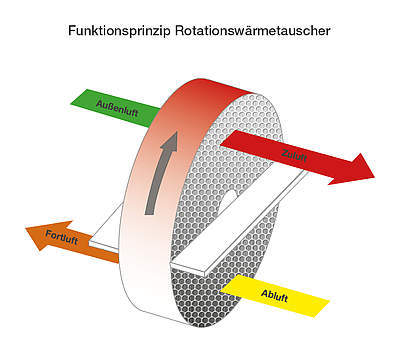
Which ventilation system with heat recovery suits your house? Compare the advantages and disadvantages of the individual ventilation systems with heat recovery here.
Conclusion - ventilation with heat recovery
There are many technological methods of heat recovery in ventilation systems. The recuperative heat recovery takes place primarily in central systems, whereby high air volume flows are spatially separated from each other and a frost protection strategy is necessary.
The regenerative heat recovery in ventilation with heat storage takes place via rotary heat exchangers for ventilation of large industrial buildings or via solid bodies made of ceramics in the decentralized systems for living space ventilation.
A heat recovery of over 93% is technically possible thanks to the honeycomb structure of the cross-section of the ceramic. The comparatively low installation effort, the low operating costs and the simple maintenance and cleaning make the decentralized ventilation units with heat recovery particularly practical, so that they are attractive both for new buildings and for subsequent renovation measures.


